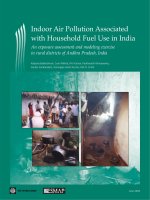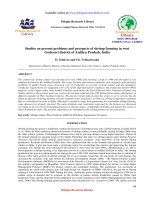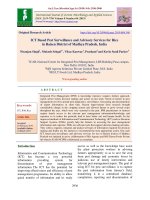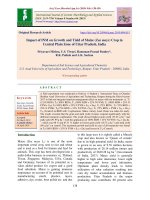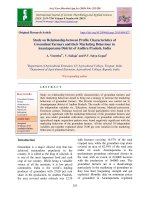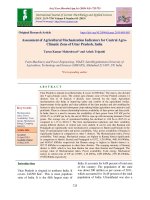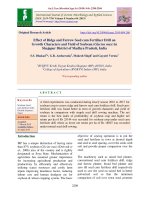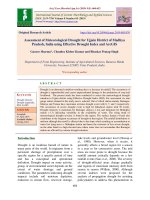Demonstration of BMP’s in sunflower for sustainable yields under black soil tracts of Rayalaseema region of Andhra Pradesh, India
Bạn đang xem bản rút gọn của tài liệu. Xem và tải ngay bản đầy đủ của tài liệu tại đây (660.73 KB, 8 trang )
Int.J.Curr.Microbiol.App.Sci (2019) 8(9): 2894- 2901
International Journal of Current Microbiology and Applied Sciences
ISSN: 2319-7706 Volume 8 Number 09 (2019)
Journal homepage:
Original Research Article
/>
Demonstration of BMP’s in Sunflower for Sustainable Yields under Black
Soil Tracts of Rayalaseema Region of Andhra Pradesh, India
Madaka Madhan Mohan*, S. Ramalakshmi Devi and A. Veeraiah
Krishi Vigyan Kendra, Utukur, Y.S.R District, A.P, India
*Corresponding author
ABSTRACT
Keywords
Best Management
Practices, Cluster
front line
demonstrations,
Integrated nutrient
management
Article Info
Accepted:
25 August 2019
Available Online:
10 September 2019
Cluster front line demonstrations were organized in sunflower crop under NMOOP-2016
to enhance the productivity and profitability by demonstrating Best Management Practices
(BMP’s) about 24 ha area in farmer’s fields of KVK operational villages namely
Kumarampalli village of Vempalli mandal and Jogireddypalli of Chakrayapeta mandal of
Y.S.R district of Andhra Pradesh through participatory approach. KVK scientists
demonstrated the BMP’s viz., Sowing of only two seeds per hill under Ridge and furrow
system; Adopted Integrated Nutrient Practices viz., 75-90-30 N-P2O5-K2O, Neem cake
powder @ 500 kg/ha, PSB @ 5 kg/ha, Sulphur granules @ 25 kg/ha, Boron @ 5 kg/ha and
Zinc (12%) @ 2.25 kg/ha; Soil Application of Trichoderma viride @ 2.5 kg/ha to prevent
fungal diseases; Maintained optimum Crop stand by adopting Thinning practice at 15 DAS
by keeping one seedling per hill; Adopted Integrated management practices for the
management of Necrosis viral disease viz., Border crop with four rows of Jowar,
Parthenium eradication around the demonstrated fields on participatory approach and
Vector control by spraying Monocrotophos @ 1.6 ml/lit at 20, 40 DAS and Imidachloprid
@ 0.4 ml/lit at 50 DAS; Prophylactic spraying of Hexaconazol @ 2 ml/lit for Alternaria
leaf spot against farmer’s cultivation practices namely sowing 4-5 seeds per hill, complex
fertilizer (28-28-0) application, no border crop and no pesticide sprays up to 60DAS etc.
The average yield of 1371 kg/ha was recorded in demonstration practice and which is 30.5
percent higher than the farmer’s cultivation practice and also 69.8 percent and 110 percent
higher than the district (809 kg/ha) and state average productivity(650 kg/ha) respectively.
The highest net returns of Rs 15985/- per ha was recorded in demonstration practice
against loss of Rs.6151/- per ha by farmer’s practice and also Rs. 7500/- per ha was saved
by adoption of BMP’s versus farmers practice of sunflower cultivation.
Introduction
Sunflower is major oil seed crop being grown
in the district because of its short duration and
photo insensitive in nature and hence it has
wider adoptability as a catch crop during the
period when the land is otherwise fallow in
black soil tracts of Rayalaseema districts of
Andhra Pradesh. Sunflower oil is a rich source
of linoleic acid (64 %) and it is good for heart
patients and hence it can play an important
role in meeting out the shortage of edible oil
requirement of our country. Globally
sunflower is cultivated over an area of 23.71
2894
Int.J.Curr.Microbiol.App.Sci (2019) 8(9): 2894- 2901
M ha with the production of 32.39 Mt and
productivity of 1,366 kg ha-1 that accounts for
nearly 8.5% of total world’s oilseeds
production (Nayak et al., 2010). The average
sunflower productivity in India is low, i.e.
around 607 kg ha−1 (Hegde, 2012). In India,
sunflower is being cultivated in the states of
Karnataka, Maharashtra and Andhra Pradesh
of which Karnataka alone accounts for nearly
54% of cultivated area. In these states, it is
mainly cultivated in rainfed regions where
average annual rainfall is less than 650 mm
coupled with uneven distribution. At present
the sunflower area is shrinking year by year
causing worry to policy makers because of its
production constraints like frequent drought
spells, lack of awareness on balanced
fertilization, soil test based fertilizer
application and importance of thinning
operation, border cropping, high incidence of
necrosis and Alternaria leaf spot diseases, bird
damage and finally lack of remunerative price
compare to other oil seed crops made
sunflower unattractive for farmers and
diversified to bengalgram, castor, sesame etc
in the district. But sunflower has the potential
to yield at least 2,000 kg/ha under rainfed and
limited irrigation conditions with existing
hybrids if crop is raised with Best
Management Practices (BMP’s).
It is therefore necessary to address the existing
production constraints of sunflower by
creating awareness among the farming
community through capacity building
programmes and front line demonstrations
with technological interventions to enhance
net returns and to prove the sunflower as
remunerative. Krishi Vigyan Kendra’s have
village level network with Dept. of
Agriculture meant for introducing the new
technology through assessment, refinement
and demonstration of proven technologies
under different micro farming situation (Das,
2010). The main objective of cluster front line
demonstration was to increase the sunflower
productivity
through
improved
crop
management practices. The newly and
innovative
technology
having
higher
production potential under the specific
cropping system can be popularized among
sunflower growing tracts of Y.S.R district
through cluster approach.
The present study was undertaken to
demonstrate the performance of Best
Management Practices (BMP’s) in sunflower
cultivation
under
cluster
front
line
demonstrations – NMOOP during 2015-16.
Materials and Methods
The present study was conducted in 24 ha area
and 51 farmers holdings from KVK
operational villages namely Kumarampalli
village of Vempalli mandal and Jogireddypalli
of Chakrayapeta mandal of Y.S.R district of
Andhra Pradesh where the sunflower grown
extensively during rabi season. The study area
between 140 16’ 80’’N latitude & 780 28’
72’’E longitude and falls under semi arid type
of climate with average annual rainfall of 710
mm mostly from south west monsoon period
(June - September) and the soils are black
soils having low inherent fertility status. The
representative
soil
samples
from
demonstration fields were collected at 0-15 cm
immediately after harvest of kharif crop and
analyzed for soil fertility status by following
standard procedures and recommended the
fertilizers as per soil test values and the
average soil fertility status and fertility
recommendations based on soil test values are
furnished in Table.1. The soils are slightly
alkaline (7.5 – 8.2) reaction, slightly saline
(0.10 – 0.18 d S-1 m-1), low in available
nitrogen (110 – 162 kg/ha), medium to high in
available phosphorous (26.5 – 75.5 kg/ha) and
available potassium (160 – 375) and sulphur is
deficient to sufficient in range (4.0 – 22.5
ppm). The best management practices in
sunflower like Sowing of only two seeds per
2895
Int.J.Curr.Microbiol.App.Sci (2019) 8(9): 2894- 2901
hill under Ridge and furrow system; Soil test
based Integrated Nutrient Practices viz., 7590-30 N-P2O5-K2O, Neem cake powder @
500 kg/ha, PSB @ 5 kg/ha, Sulphur granules
@ 25 kg/ha, Boron @ 5 kg/ha and Zinc (12%)
@ 2.25 kg/ha; Soil Application of
Trichoderma viride @ 2.5 kg/ha against
fungal diseases; Thinning practice at 15 DAS
by keeping one seedling per hill to maintain
optimum crop stand ; Adopted Integrated crop
management practices for the management of
Necrosis viral disease viz., 1. Border crop with
four rows of Jowar, 2. Parthenium eradication
around the demonstrated fields 3. Vector
control by spraying Monocrotophos @ 1.6
ml/lit at 20, 40 DAS and Imidachloprid @ 0.4
ml/lit at 50 DAS; Prophylactic spraying of
Hexaconazol @ 2 ml/lit for Alternaria leaf
spot at 70 DAS and shiny ribbon around the
cultivated field were demonstrated against the
farmer’ cultivation practices namely more
number of seeds per hill on flat bed method;
only complex fertilizer application (28-28-0)
without any other sulphur, boron and zinc
fertilization; no border crop, prophylactic
sprays against vector control and Parthenium
around the fields and no measures for bird
damage at maturity stage.
The demonstrated field was ploughed twice
and levelled and prepared ridge and furrows
with tractor drawn ridge former. The
sunflower hybrid SIRI- 555 was sown by
manual dibbling on the top side of the ridge
with the spacing of 60 cm X 30 cm and the
crop sown during second F.N of January.
The extension gap, technology gap and the
technology index for sunflower cultivation
were worked out (Samui et al., 2000) as
mentioned below:
Extension gap = Demonstration yield farmers’ yield (control)
Technology gap = Potential yield demonstration yield
Technology index = Potential Yield –
Demonstration Yield/ Potential Yield x 100
Results and Discussion
Under NMOOP -2015-16 provided the critical
inputs and services viz., soil health cards of
demonstrated fields, sulphur granules @ 5 kg,
Trichoderma viride @ 1 kg, PSB @ 2 kg,
Borox @ 2 kg, chelated ZnSO4 @ 500 g and
Imidachloprid @ 250 ml to the participatory
farmers of both cluster villages. The
demonstrated farmers applied chemical
fertilizers as per the soil test values (Table.1)
and boron, zinc sulphate were applied at basal
only along with chemical fertilizers. T. viride
multiplication was demonstrated through
method demonstration and all demo farmers
applied to soil after incubation of 15 days
under shade during sowing. At 10 DAS
scientists demonstrated the thinning operation
by keeping only one seedling per hill instead
of 3-4 seedlings per hill observed in farmer’s
practice.
Hence the crop was healthy and robust growth
at initial vegetative stage in demonstrated field
compared with farmer’ practice by preventing
the competition for nutrients, water among the
seedlings and the application of soil test based
fertilizer application reduced the cost to be
spent on fertilizers, the sucking pest complex
load especially white files was greatly reduced
with prophylactic spraying of Monocrotophos
@ 1.6 ml/lit at 20, 40 DAS and Imidachloprid
@ 0.4 ml/lit at 50 DAS and thereby necrosis
disease which is transmitted by white flies was
managed effectively and affected plants of 2.0
to 5.0 percent observed in demonstration field,
whereas in case of farmers practice affected
plants up to 25 percent which caused 30
percent yield reduction compared to
demonstration. Two hand weedings were
carried out and maintained weed free during
crop growth which further reduced the
inoculum load for necrosis and Alternaria leaf
2896
Int.J.Curr.Microbiol.App.Sci (2019) 8(9): 2894- 2901
spot diseases compared with farmer’s practice.
The head emergence was fast, complete and
seed setting was very good at centre of head in
demonstration practice compare to farmer’s
practice due to soil application of Borox @ 5
kg ha-1. The low incidence of Alternaria leaf
spot up to 5to 10 percent in demonstration
practice where as it is up to 20 percent in
farmer’s practice. The bird damage was also
minimised by erecting shiny ribbon around the
demonstrated field compared to farmer’s
practice. By adoption of best management
practices through demonstrations versus
farmer’s practice addressed the all production
constraints resulted increased productivity and
profitability by minimizing the cost incurred
on fertilizers, seed and pesticides etc in
sunflower. The average was recorded through
demonstrations is 1371 kg ha-1 with maximum
of 2250 kg ha-1 & minimum of 912 kg ha-1
which is 30.5 percent higher than farmer’s
practice (952 kg ha-1) and 69.8 percent and
110 percent higher than the district (809
kg/ha) and state sunflower average
productivity(650 kg/ha) respectively.
.
Table.1 Average Initial soil fertility status and fertilizer recommendation based on soil
test values in CFLD’s sites
S.No
Soil parameter
Range
Fertilizer recommendation based on soil test
values
1
Soil reaction (pH)
--
2
Electrical conductivity
(d S-1m-1)
7.5 – 8.2 (slightly
alkaline)
0.10 – 0.18
(slightly alkaline)
3
Available nitrogen
(kg ha-1)
110 – 162 (Low)
25 percent higher than recommended nitrogen
(87.5 kg ha-1) was applied to the crop in three
splits: first split at sowing (50 %), second at 30
DAS (25 %) and third at bud formation stage (25
%)
4
Available Phosphorous
(kg ha-1)
26.5 – 75.5
(medium to high)
5
Available potassium
(kg/ha)
160 – 375
(medium to high)
6
Available sulphur (ppm)
7
Micronutrients like Zinc
& Boron
4.0 – 22 .5 (low to
sufficient)
Deficient
Recommended phosphorous (90 kg ha-1) was
applied to the crop where soil having medium (22
– 56 kg/ha) P2O5 status, whereas, 25 % higher than
recommended phosphorous (112 kg ha-1) applied
to soil having high (>56 kg ha-1) P2O5 content
Recommended potassium (30 kg ha-1) was applied
to the crop where soil having medium (150 – 300
kg ha-1) K2O status, whereas, 25 % higher than
recommended potassium (37.5 kg ha-1) applied to
soil having high (>300 kg ha-1) K2O content.
Applied 10 kg of sulphur granules to the crop
2897
--
Soil application of Borox @ 5 kg ha-1and Zinc
(12%) @ 2.25 kg ha-1 before sowing
Int.J.Curr.Microbiol.App.Sci (2019) 8(9): 2894- 2901
Fig.1 Location map of the cluster front line demonstrations in sunflower with depiction of
latitude and longitude of the study area
Table.2 Productivity of sunflower under demonstration and farmer’s practice under
Cluster front line demonstrations – NMOOP 2015-16
S.No
Treatment s
1
Farmer’s
practice
Demonstratio
n practice
Std. Deviation
2
Number
of
demonstr
ations
51
51
Mean
Yield
(kg ha-1)
Mean
Gross
income
(Rs. ha-1)
Mean Net
income
(Rs. ha-1)
Mean
B:C
ratio
Extensio
n gap
(q ha-1)
Technolo
gy gap
(q ha-1)
Techn
ology
index
952 kg
33320
-6180
0.84:1
1.44
6.29
31.4
1371 kg
47985
15985
1.50:1
t- value
164
279
8.9**
5750
9784
8.9**
-5819
15976
13.7**
p- value
0.00
0.00
0.00
(** significant at 1 percent level)
2898
Int.J.Curr.Microbiol.App.Sci (2019) 8(9): 2894- 2901
Table.3 Extension and capacity building activities organized during cluster front line
demonstrations during 2015-16
S.No
1
Extension Activities
Organized
Date and Place of Activity
Pre-season training on
Integrated Crop Management
practices in sunflower
cultivation
Method demonstration on Soil
Application of Trichoderma
viride and PSB
Kumarampalli on 02-012016
Number of
Farmer
Attended
42
Kumarampalli on 7-01-2016
22
3
Result demonstration of Sulphur Kumarampalli on 7-01-2016
and Boron fertilization
18
4
Result Demonstration of
Thinning in sunflower
Kumarampalli &
Jogireddypalli on 25-1-2016
30
5
Mid-season training programme
about Necrosis management in
sunflower
Kumarampalli & 23-01-16
27
6
7
Monitoring team visit
Field day
Kumarampalli & 28-01-16
Kumarampalli & 12 -04-16
40
30
2
Photographs
Conducted pre season training programme to
demo farmer’s and providing critical inputs
Performed thinning operation at 10 DAS
2899
Int.J.Curr.Microbiol.App.Sci (2019) 8(9): 2894- 2901
Field visit by the team of scientists to
demonstrated fields
Mid season training programme on integrated
crop management practices in sunflower to the
participatory farmers
Dr.S.M.Kolhatkar, Director, DOD and
Dr.A.R.Reddy, ATARI, ZONE-V visited
sunflower demonstrations
Filed day and crop cutting experiement was
oragnized and recoreded 2200 kg ha-1 and
which is highest ever in the district
The extension gap for sunflower in the district
is 1.44 q ha-1and technology gap is still around
6.29 q ha-1 where as technology index is 31.4
it indicates there is greater scope for
productivity enhancement by implementing
technological interventions in sunflower. The
best management practices demonstrated
farmer’s incurred 23.4 percent less cost on
cultivation compared with farmer’s practice
(Rs.39,500 ha-1) cost of cultivation. The
average gross returns of Rs. 47,985 ha-1 was
recorded in demonstrations and which is about
30.5 percent higher than the farmer’s practice
(Rs.33,320 ha-1) with B:C ratio of 1.50:1 and
0.84:1 respectively which indicates negative
returns of Rs. 6180 ha-1 recorded in farmer’s
practice due to low yields coupled with
increased cost of cultivation. The monitoring
team of Dr.S.M.Kolhatkar, Director, DOD,
Ministry
of
Agriculture,
GOI
and
Dr.A.R.Reddy, ATARI, ZONE-V visited the
demonstrated sites and observed the
implementation of best management practices
in farmers fields. Farmers expressed
satisfaction pertaining to critical inputs
provided and technical knowhow throughout
the demonstrations. The yield and cost
economics pertaining to the demonstrations
are furnished hereunder.
Cluster frontline demonstration in sunflower
organized in KVK operational villages of
Y.S.R district and result concluded that
average yield 1371 kg ha-1 was recorded in
2900
Int.J.Curr.Microbiol.App.Sci (2019) 8(9): 2894- 2901
Best
Management
Practices
(BMP’s)
demonstrated fields as compared to 952 kg ha1
recorded farmer’s practice plot. This was
30.5 percent increase in yield over farmers
practice(952 kg ha-1) and 69.8 percent and 110
percent higher than the district average (809
kg/ha) and state average productivity(650
kg/ha) respectively.
The extension gap for sunflower in the district
is 1.44 q ha-1and technology gap is still around
6.29 q ha-1 where as technology index is 31.4
it indicates there is greater scope for
productivity enhancement by implementing
best technological interventions in sunflower
through demonstrations and capacity building.
The successful implementation of frontline
demonstration and various extensions
activities like training programme, field day,
exposure visit organized in CFLDs
programmes in the farmer’s fields leads to
horizontal spread of BMP’s to the other
sunflower growing tracts of Rayalaseema
region
References
Das Mamoni, Puzari N N and Ray B K 2010.
Impact of training of skill and
knowledge development of rural
women,
Agricultural
Extension
Review, 1(1): 29-30
Nayak, A., Gracy, C.P., Nagashree, N.,
Girisha, K.. 2010. An overview of
Sunflower in India. KrishiSeva.com.
Hegde, D.M., Sudhakara Babu, S.N., 2009.
Declining factor productivity and
improving nutrient use efficiency in
oilseeds. Indian Journal of Agronomy
54: 1–8.
Samui S K, Maitra S, Roy D K, Mandal A K
and Saha D (2000). Evaluation of
frontline demonstration on groundnut.
J Indian Soc Costal Agric Res 18
(2):180-183.
How to cite this article:
Madaka Madhan Mohan, S. Ramalakshmi Devi and Veeraiah, A. 2019. Demonstration of
BMP’s in Sunflower for Sustainable Yields under Black Soil Tracts of Rayalaseema Region of
Andhra Pradesh, India. Int.J.Curr.Microbiol.App.Sci. 8(09): 2894- 2901.
doi: />
2901
